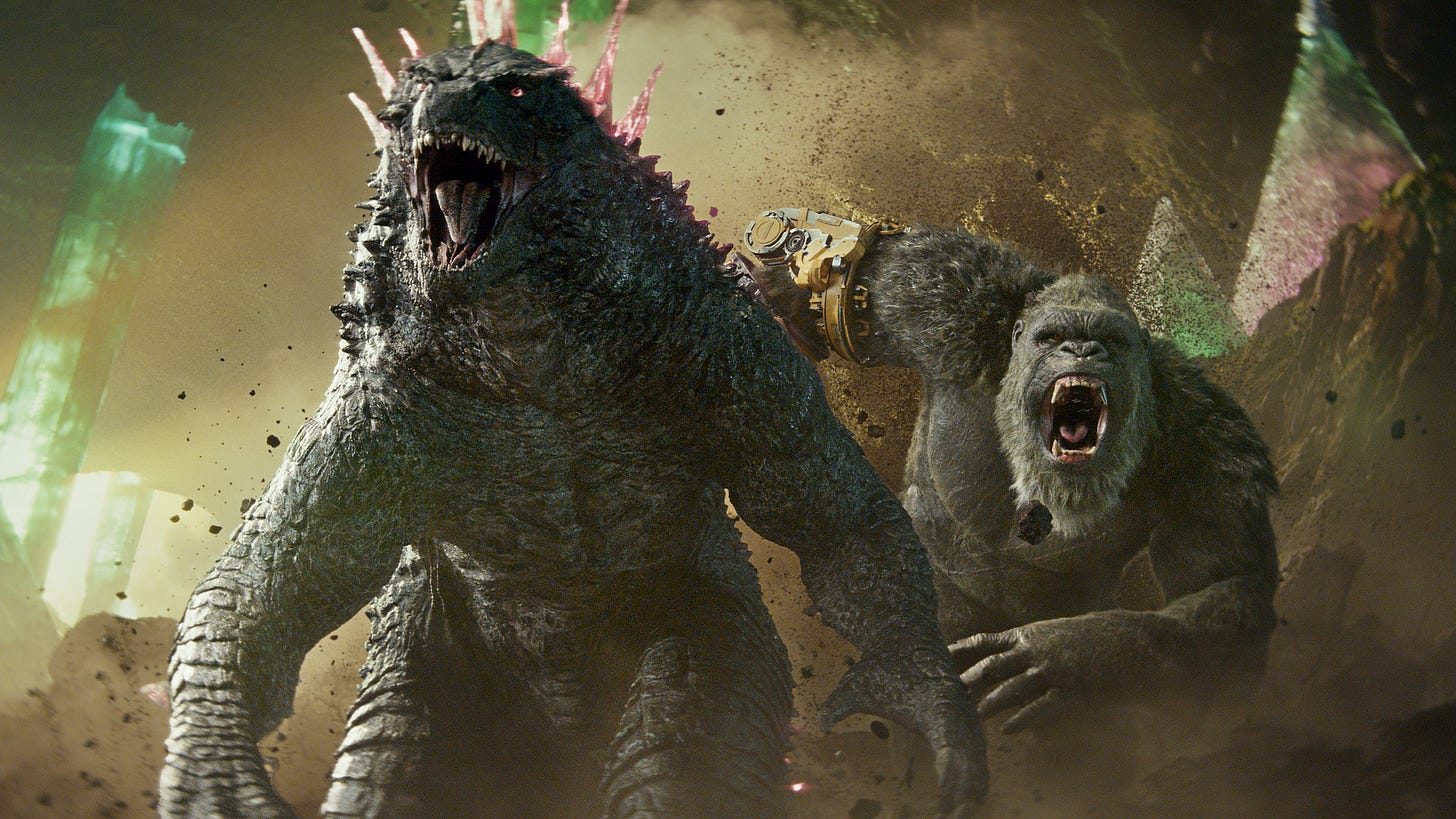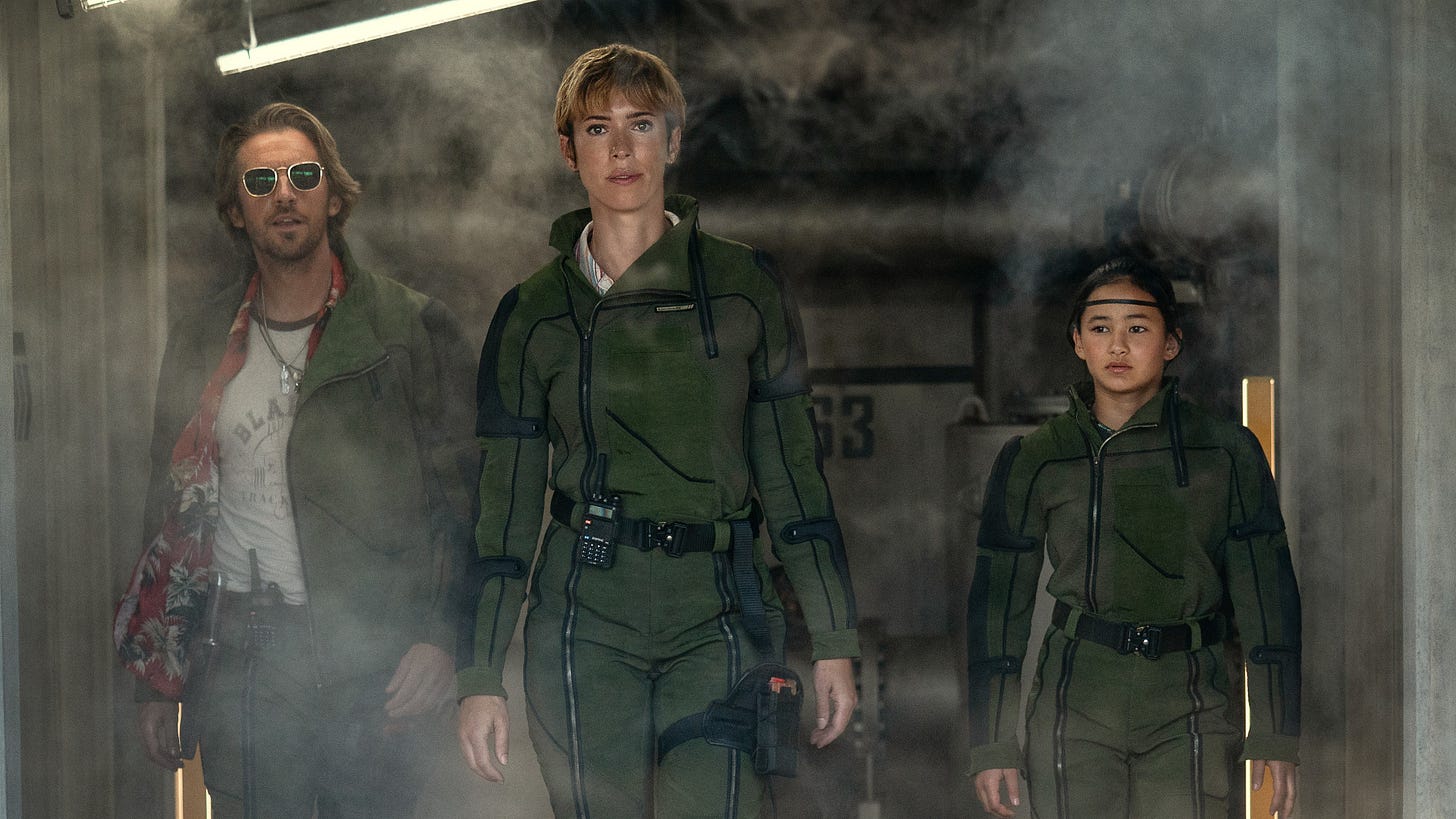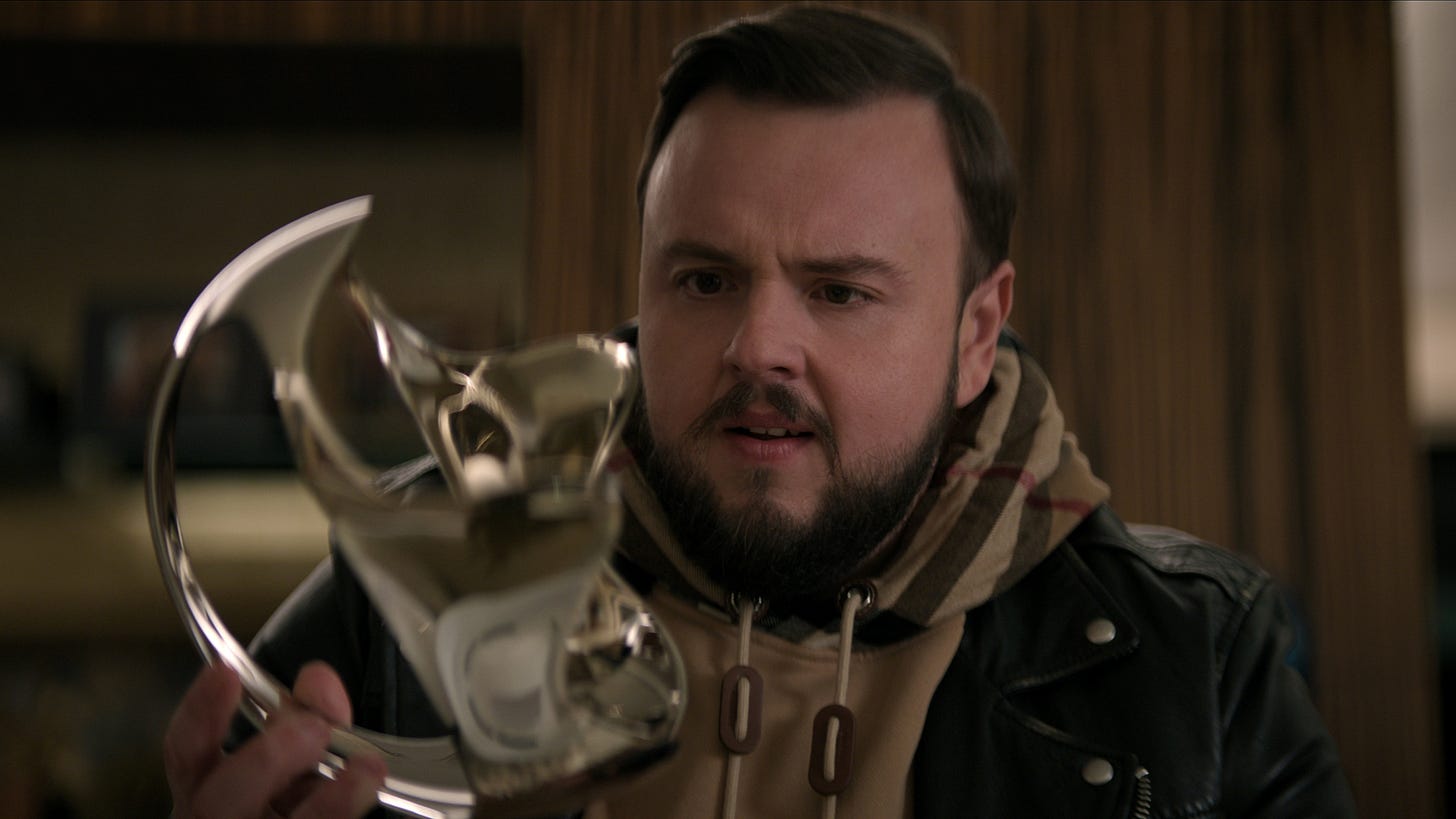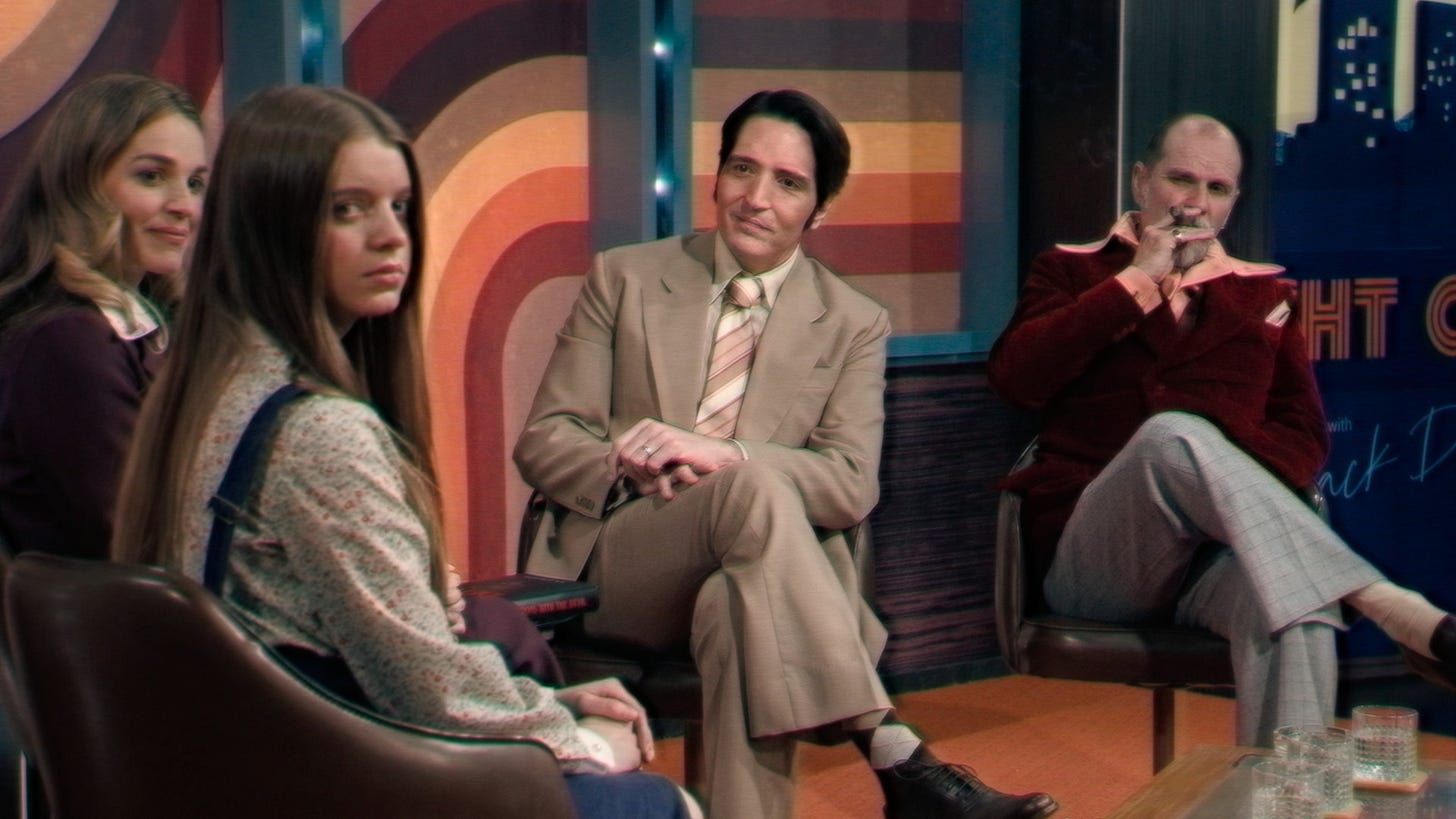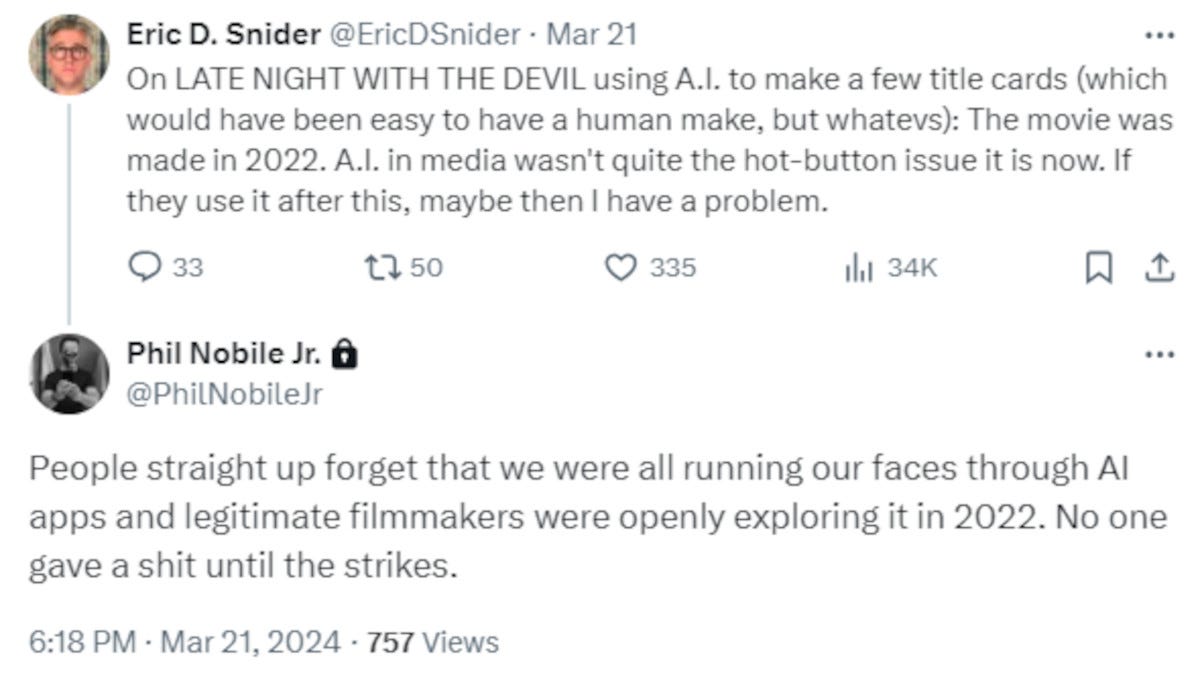OMFGodzilla
I was desperate for a kaiju to punch me in the face for most of it. Also, God(zilla) help me, I've waded into the Late Night with the Devil AI debate.
Thanks to those of you who have already subscribed after my first post. Any further support would be much appreciated and, just as a reminder, the whole newsletter is completely free for now.
Hollow Earth, meet hollow movie
The MonsterVerse over at Warner Bros is a very curious thing indeed. We started a decade ago with Gareth Edwards’ weirdly coy game of kaiju peekaboo in Godzilla, followed it with the equally middling Kong: Skull Island, and then snoozed through the galumphing disaster that was Godzilla: King of the Monsters. Fortunately for this franchise, Adam Wingard’s enormously silly Godzilla vs. Kong was exactly what we all needed as we emerged blinking into the open after a year and change of pandemic lockdowns.
That brings us to Wingard’s return for the bafflingly titled Godzilla x Kong: The New Empire. It had lots of very difficult questions to answer. What else lives in the Hollow Earth? Can these two titans co-exist? What the heck does that X mean?
Some of those questions are answered in the movie — not the one about the X, sadly — but it also poses plenty more. Notably, how can a blockbuster film about warring behemoths in a subterranean wonderland be this tedious?
The story begins with Godzilla and Kong separated by the divide between worlds. Lizard Boy is waging occasional kaiju wars on the surface, while Axeman Ape is marauding around the Hollow Earth being a badass. That’s until Kong tumbles down a sinkhole and uncovers an even older civilisation of great apes with less than honourable intentions for the surface world. It’s very much the Qui-Gon Jinn school of storytelling — there’s always a bigger fish.
Unfortunately, that’s as far as we go in terms of ideas. The human characters are even more perfunctory than usual — Dan Stevens doing Aussie-cum-Kiwi-cum-Mockney is unforgettable in the worst way — and the plot is threadbare even for a movie about giant creatures twatting each other in the face. So close to Godzilla Minus One’s Oscar-winning revitalisation of kaiju storytelling, this feels unforgivable.
The core problem is that, with so much of the story taking place in the CGI environs of the Hollow Earth, the sense of scale is gone. Are these creatures massive or proportionate? How big is the transparent merchandise play Diddy Kong? (sorry, Nintendo) When they all fight, these guys just look like specks floating in digital space, rather than massive, tangible beasts capable of doing damage outside of a computer.
Wingard, to his credit, realises this enough to transplant the third act to Rio de Janeiro for some crumbly building action. But without any sense of the human peril involved — it’s all banal platitudes about “saving the world” — it doesn’t feel any more physical and important than it did beneath the surface.
Ultimately, it feels like they’ve just run out of ideas at this point. When you’ve swapped the Mothras and the Ghidorahs of the world for a villain straight out of The Mighty Boosh, something has gone wrong. “What if Kong was red?” is not enough of a brainstorm session for a blockbuster with a six-figure budget. Godzilla vs. Kong felt like the rampaging id of this franchise but, in attempting to deepen its mythology, this new entry has fallen apart.
We’ve been asking for more monsters and fewer humans and, to be fair, Wingard delivered that. Unfortunately, he forgot that, without humans, you need to find another way to inject stakes. When this is just an existential war for the survival of a few thousand pixels, it’s really hard to care.
I do want a plushie of the tiny Kong, though. Two stars for the film; five for the merchandising team.
Some mothers do scare ‘em
Godzilla and Kong wish they could match the titanic status of Anne Hathaway and Jessica Chastain. Watching them go toe to toe on the big screen is akin to a WrestleMania championship match. But, to be honest, it’s difficult to know what to make of Mothers’ Instinct.
Its cinematic heritage is clear. This is one of those “there’s something twisted behind the white picket fences of suburbia” movies, so fill in your comparison of choice: The Stepford Wives, Blue Velvet, American Beauty, all the way through to the risible Matt Damon black comedy Suburbicon. Set in the 1960s, it follows the fractured relationship between neighbours Céline (Hathaway) and Alice (Chastain) after one of them is hit with a terrible tragedy.
To say more would be to spoil the surprises of the narrative but, ultimately, seasoned cinematographer Benoît Delhomme’s directorial debut — a remake of a Belgian thriller — isn’t nearly as twisty as you want it to be. Initial layers of psychological intrigue and lashings of high camp — I was reminded of the more deliberately over-cranked parts of May December — give way to shrieking insanity, and not even the fun kind, in the third act.
But, despite all of that, I had a really good time. Chastain and Hathaway sink every perfectly white tooth in their mouths into Sarah Conradt’s intentionally ripe script, with Hathaway in particular relishing the shifting personas of Céline. Chastain’s work is necessarily more subdued, but her take on a potential victim of murderous gaslighting is very watchable indeed.
This film might not shock and enthral the way it wants to, but there’s no denying the intensity of the heavyweight clash between Hathaway and Chastain. That’s worth its weight in melodramatic gold.
Lost in a Silver Haze
I was utterly wowed by Sacha Polak’s first English-language feature Dirty God back in 2019. She has reunited with that film’s star, Vicky Knight, for her follow-up Silver Haze. This time, it’s even more personal for Knight, as the story is heavily inspired by her own childhood, in which she suffered serious burns in a fire at the pub where she lived. Some of the supporting players are her real family members.
What’s most impressive about Silver Haze is that it’s an absolute shape-shifter of a film. Every time you feel you know what it’s going to be, it changes and morphs into something else, orbiting around Knight’s protagonist Franky. It depicts her search for justice, but also her burgeoning romance with one of the patients at the hospital where she works (Esmé Creed-Miles). Then it becomes something else entirely when Franky finds another surrogate family.
Ultimately, this makes for a bit of a narrative jumble, but Knight is such a unique screen presence — you want to support Franky, even when she does awful things — that all of the disparate parts make sense amid her gravitational pull. It’s a more complex film than Dirty God — and often a more frustrating, mercurial one — but it’s just as fascinating and fulfilling. It’s well worth catching, and you can find out more about the BFI’s cinema release here.
Turns out I really love sci-fi maths
Last year, I watched Apple TV’s thinky sci-fi series Foundation for the first time, with low expectations. Hard sci-fi isn’t my thing; I prefer it soft, squishy and more than a little silly. But Foundation reorientated my take on the genre entirely with its epic tale of cloned emperors and mathematical foresight. It’s now one of my favourite TV shows and I’m very much hoping the behind-the-scenes turmoil around season three doesn’t hurt it too much.
So with my newfound love of this sort of thing, I decided to give 3 Body Problem a go on Netflix, burning through all eight episodes in less than 24 hours. I wrote for Radio Times this week about how it’s actually very ill-suited to binge viewing, but I still very much enjoyed the show.
Created by Game of Thrones showrunners David Benioff and D.B. Weiss, the series is based on the first in a trilogy of sci-fi novels by computer engineer turned writer Cixin Liu. It’s a complex tale in which a string of suicides in the scientific community triggers an investigation involving a super-advanced virtual reality game built around the physics conundrum of the title, not to mention a pivotal decision made in the wake of the Chinese Cultural Revolution.
Over the course of just eight episodes, the show gets through a lot of material. The world we leave at the open-ended conclusion of the series couldn’t be more different to the familiar one we join in episode one. Benioff and Weiss know how to do epic.
3 Body Problem never feels like it’s in a hurry, allowing the first half of the series to unfold at a methodical and thoughtful pace before really amping up the spectacle once the truth of the story is unveiled. There’s one (clearly very expensive) set piece in episode five that is genuinely one of the most shocking and brutal things I’ve seen in a TV show for years. I almost had to go for a lie down afterwards.
But the show also very much has characters at its heart. Jess Hong particularly shines as genius physicist Jin Cheng — thrust into a level of prominence for which she gets no time to prepare — while Eiza González’s take on the guilt of nanotech pioneer Auggie Salazar is heart-breaking. Meanwhile, Benedict Wong provides a joyously snarky lighter side to proceedings as no-nonsense Mancuian investigator Da Shi.
The second half of the series does feel a little over-stuffed and, at times, the show’s ambition exceeds its grasp a little. But as big idea sci-fi goes, this is deeply impressive in both spectacle and substance. Unfortunately, though, this is a Netflix binge-watch and so nobody will be talking about it in a week’s time. It’s just the way of the world.
Is AI ever tolerable in movies?
Last week, I wrote about one of my favourite films of 2024 so far — the chilling talk show horror Late Night with the Devil. The day after I saw the movie, the filmmakers admitted that a handful of pieces of artwork used for interstitials in the show-within-the-movie were created with the help of generative AI. I’ll quote the Cairnes Brothers’ statement to Variety in full:
“In conjunction with our amazing graphics and production design team, all of whom worked tirelessly to give this film the 70s aesthetic we had always imagined, we experimented with AI for three still images which we edited further and ultimately appear as very brief interstitials in the film. We feel incredibly fortunate to have had such a talented and passionate cast, crew and producing team go above and beyond to help bring this film to life. We can’t wait for everyone to see it for themselves this weekend.”
The response to this has been weird and, actually, sort of tribal. Many people who saw and enjoyed the film prior to this revelation have been keen to defend it against the other camp — those who flat-out refuse to see a movie that utilised AI in any way, or feel tricked if they paid to see it before they found out.
A quick glance at the Letterboxd page for Late Night with the Devil shows this duality pretty clearly, with the most popular review stating clearly: “Don’t let this be the start of accepting this shit in your entertainment.”
My own feelings on this are quite complicated. Naturally, my instinct is to defend the film. I absolutely loved it and would hate to see the work of dozens of genuine creatives binned and forgotten because corners were cut in one specific aspect of the project. Film is a collaborative medium and so I always think it’s a shame to call for a boycott because of the actions of one member — or a few members — of the team.
However, the creeping influence of AI on our art is absolutely something that needs stamping out in no uncertain terms. I completely understand the strength of feeling, particularly from those who, like me, work in industries vulnerable to the rise of AI. If people want to draw a red line, I get it and I respect it.
One aspect that I haven’t seen talked about as much, though, came to my attention in a Twitter exchange between critics Eric D. Snider and Phil Nobile Jr. They pointed out that, when Late Night with the Devil was made in 2022, AI wasn’t seen as quite as harmful as it is now.
In fact, apps like Lensa were very popular, using AI to generate stylised avatars for social media. As recently as December 2022, dozens of online publications were reporting on the AI avatar trend, and nobody seemed all that bothered. Objections were made, but they were fairly quiet in among all of the people sharing pictures of themselves morphed into various high school yearbook archetypes.
Of course, this doesn’t absolve the filmmakers of responsibility. Late Night with the Devil premiered a year ago at the SXSW Festival and it would have been easy for those images to have been replaced between then and its wide release. But certainly, AI wasn’t seen as nearly as much of an existentially threatening demon in 2022. The change in attitude since then, if anything, underscores just how rapid the development of the technology has been.
The solution to all of this, clearly, has to come from regulation. One of the big achievements of the SAG and WGA strikes last year was protection for their members from the influence of AI. That now has to be passed on to other workers within the TV and film industry, including designers and illustrators. Studios, obviously, are going to want to cut costs where possible, and there does need to be a resistance to that.
However, I’m not sure completely rubbishing a fairly low-budget horror film is 100% the answer. I think the best solution at this stage is to note the controversy when discussing the film, so it doesn’t go unnoticed. As the film’s star David Dastmalchian said this week, “it’s an important conversation, we gotta have it”. But at this stage, conversation is better and more useful than condemnation.
That’s it. Please let me know which bits of this you liked (if any) and whether or not I’m wasting my time by trying to make this into something. See you same time next week for more reviews, opinions and film-y stuff!


